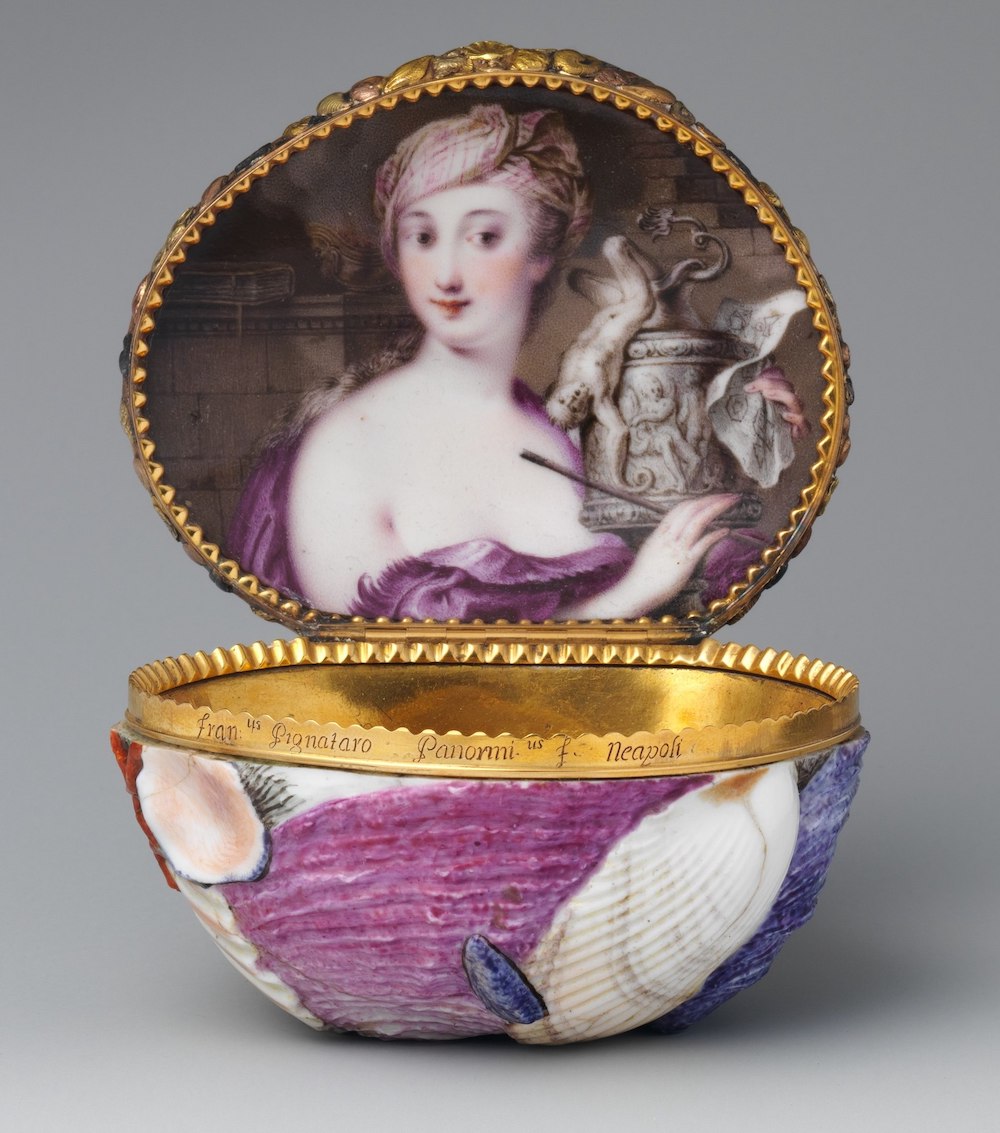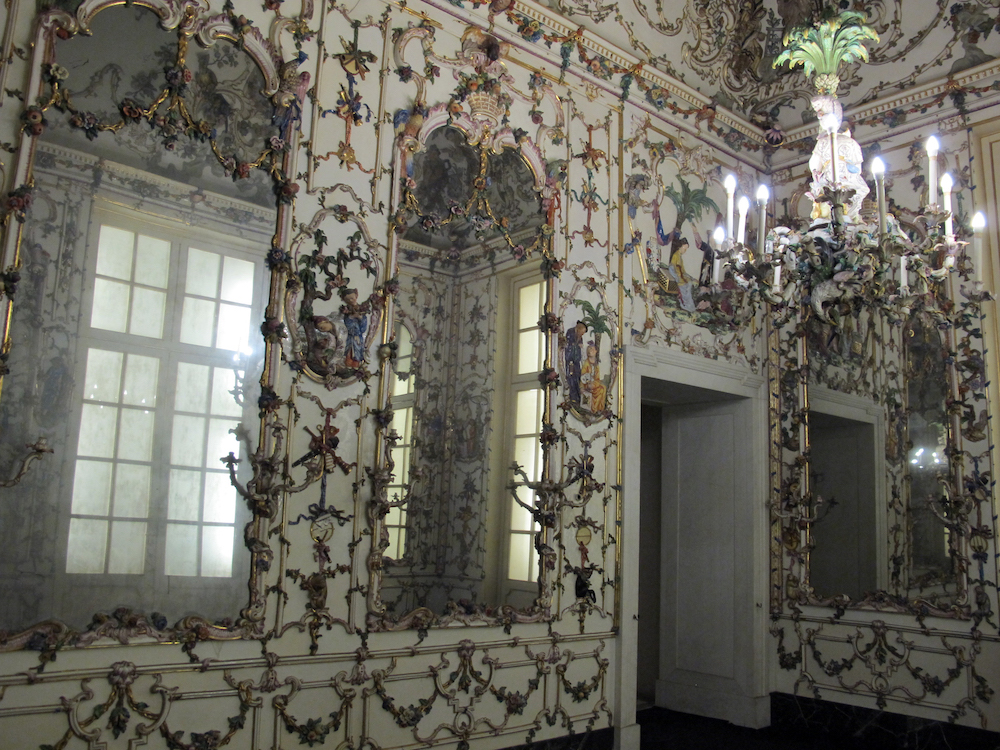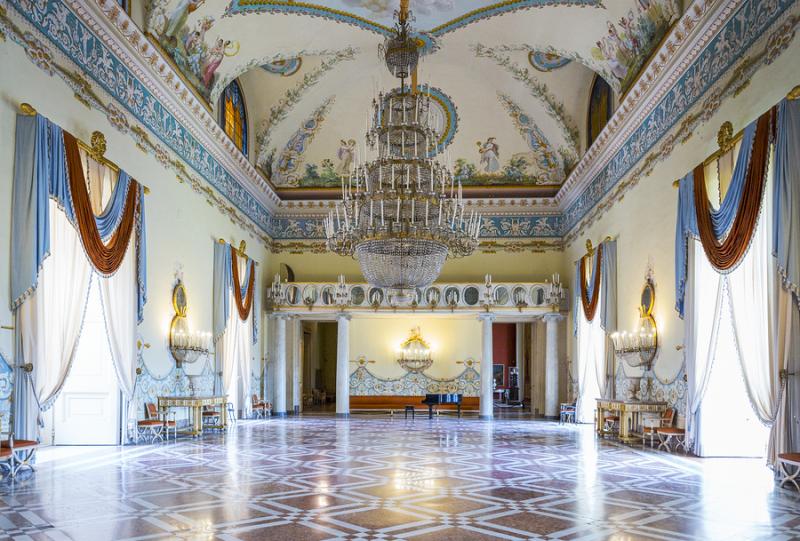Capodimonte is a distinctive style of porcelain that stands apart from all the other ceramic traditions of southern Italy. This delicate, ornate porcelain--historically produced outside of Naples-- is immediately recognizable for its tiny pastel flowers, sprays of buds, baskets, and elegant figurines. Today Capodimonte is a popular collectible throughout Italy as well as abroad.
WHERE DID CAPODIMONTE COME FROM?
Throughout the Middle Ages, European traders and explorers brought small works of porcelain home from their travels in Asia. However, the history of European porcelain begins in the seventeenth century, when traders began to import porcelain from Asia in larger numbers. These hard, durable, yet delicate and translucent white vessels appeared novel. Asian porcelain soon came into vogue, and in Italy, the more traditional brightly colored maiolica began to be viewed as old-fashioned.
Soon, Europeans sought to imitate Asian porcelain and produce it themselves on a large scale. By the eighteenth century, porcelain tableware and figurines were all the rage among European royal courts, and these tiny collectibles remained inaccessible to the lower classes. The upper classes coveted little figurines of peasants, delicate flowers, and other tiny porcelain wares. A brisk competition ensued for the most beautiful and sought-after porcelain works. This competitive spirit resulted in some of the world’s most enduring porcelain traditions, including Sèvres, Meissen, Wedgwood, Villeroy & Boch, Limoges, Spode, and others.

WHY NAPLES?
The Neapolitan origins of this fancy porcelain lie in the Bourbon royal court of Charles III, who ruled Naples in the 1700s. Charles’s queen, Maria Amalia Valpurga, was the granddaughter of Augustus the Strong, the founder of the Meissen factory and one of the earliest champions of European porcelain. As part of her dowry, Queen Maria Amalia brought to her marriage no less than seventeen complete table services made of Meissen porcelain.
In 1743, the king converted his hunting lodge outside of Naples, situated on a hill called Capodimonte, into a porcelain manufactory as part of the Real Fabbrica. His goal was to produce porcelain that would vie with other famous European royal porcelain manufactures, especially Meissen. His specialist artisans concocted a secret recipe that would account for a distinctive look and feel in the porcelain that would be forever associated with Capodimonte.
The king and queen, according to historians, were intensely interested in these porcelain experiments. The challenge in concocting Neapolitan porcelain was that kaolin, a type of clay considered essential to porcelain, was in short supply in Italy. The royal artisans experimented with combinations of clay pulled from sources across southern Italy until they came up with a combination that worked. The porcelain recipe eventually developed resulted in warm white tone, bringing a distinctive appearance to the works that emerged from the Capodimonte factory. The works were decorated with glazes known for their bright palette of red, yellow, orange, and green, coated with a lustrous finish.
The factory began producing full sets of tableware, vases and other vessels, as well as small decorative objects and figurines in a Baroque style typical of the mid-eighteenth century. In that early period of Capodimonte, snuffboxes were among the factory’s most popular items. Figures of theater characters such as Pulcinella, as well as Neapolitan peasants engaged in dancing, daily chores, and other pastoral activities, were also popular. Flowers became one of the most enduring subjects of Capodimonte porcelain because, according to legend, King Charles was allergic to flowers; porcelain versions were the only ones he could enjoy.
King Charles III moved porcelain production to the Buen Retiro factory in Madrid when he left Naples in 1759 upon his succession to the Spanish throne. With him, he took his key porcelain makers, a team of factory personnel, porcelain molds, and other materials. However, Charles’s son, Ferdinand VI, reopened Capodimonte when he came of age in the 1770s, rebuilding a new factory at Portici from the ground up, then moving it to the royal palace. For the next thirty years, Ferdinand’s artists continued to imitate the royal porcelain style, but the production became more mass produced, adapting to the taste of modern collectors. This second Capodimonte manufactory remained active until the French took Naples in 1806.
The large porcelain manufacture known as Doccia or Ginori, on the western outskirts of Florence, acquired what was left of Capodimonte production in the nineteenth century. In 1896, the Milanese firm Società Ceramica Richard incorporated the Doccia porcelain works, and the company became known as Richard-Ginori. The company continued to produce Capodimonte and use the royal Neapolitan trademark until recent times. Richard-Ginori declared bankruptcy in January 2013, and was purchased by Gucci.
HOW CAPODIMONTE IS MADE
From the start, Capodimonte was special, as it departed from the traditional recipe used in other porcelain centers. The unusually delicate, reflective quality of the finished pieces brought Capodimonte its distinctive style in the world of porcelain.
As in the other royal porcelain manufactures of Europe, many of the basic forms of Capodimonte wares began with a mold. The Capodimonte Museum holds thousands of these molds, ready for making scads of figurines, bouquets, small vases, and other ornamental works. It would be incorrect, however, to consider these works churned out or mass-produced. Many of the individual details, including flower buds, leaves, and individual figures, are often modeled by hand and attached to a vessel.
Once the molded vessels emerged from the kiln, they were covered with a clear glaze. Then, decoration was applied with clear, bright hues of red, orange, blue, green, and yellow. A second firing gave the finished pieces the lustrous sheen and delicacy that is synonymous with Capodimonte.
COLLECTING CAPODIMONTE
Today, Capodimonte porcelain remains popular among collectors, and the value lies partly in the marks on the undersides of each piece. Original items from King Charles’s Capodimonte and Buen Retiro porcelain factories were signed with a fleur-de-lis in blue underglaze, occasionally enclosed in a circle; only museums and private collectors with large budgets own these original pieces. Those made during the time of Charles’s son Ferdinand were demarcated with a crown and the letter N above it. These wares also command high prices when they appear in the international marketplace.
To make matters confusing, many pieces produced since the 1920s continued to bear the letter N with the crown stamped in blue on the bottom. The mark alone does not indicate a connection with the royal factory. In fact, value in these more modern pieces lies in the quality of the work rather than the mark.
Quality and value can vary tremendously in Capodimonte wares. Authentic, antique pieces originating from one of the royal manufactories commonly sell for several thousand Euro at auction, while lower-quality, mass-produced works in the style of historic Capodimonte are worth very little. The good news is that you can still find high-quality, finely made pieces that fall in the middle of this range.
EXPERIENCING CAPODIMONTE
Capodimonte Museum
Museo di Capodimonte
Via Miano, 2, Napoli
081/7499111
This former Bourbon palace, originally conceived as a royal hunting lodge atop Capodimonte Hill on the edge of Naples, is the home to the Capodimonte Museum. Today, this palace, on over three hundred acres, houses the royal family’s vast collection of paintings. The Capodimonte Museum holds a significant collection of paintings by Botticelli, Mantegna, Massaccio, and lesser-known but accomplished Neapolitan painters.
The collection also includes examples of maiolica, furniture, and other extraordinary works of Neapolitan craftsmanship. Before you buy a piece of Capodimonte porcelain, train your eye to recognize the traditional forms, colors, and patterns at this treasure-trove of a collection from the heyday of royal porcelain. Don’t leave without visiting the private bedchamber of Queen Maria Amalia of Saxony, a room whose walls and ceiling are made entirely of porcelain!
Ceramics Museum
Museo Nazionale della Ceramica Duca di Martina
Via Cimarosa, 77, Napoli
081/5788418
This eighteenth-century private country estate, the Villa Floridiana, sits inside an expansive park with a view over the Bay of Naples. The museum boasts an impressive collection of several thousand pieces of ceramics, with important holdings in Capodimonte and works from other European porcelain centers like Meissen and Sèvres. It also includes Italian maiolica, furniture, and Asian ceramics.
BUYING CAPODIMONTE
Today, there are a handful of artisanal enterprises that carry on the work of making authentic Capodimonte porcelain. They mostly supply the wholesale trade, though, which makes things a little tricky for consumers. Several shops around Naples and the region sell Capodimonte, often mixing high-quality pieces alongside lower-quality, mass-produced items. If you want to buy something authentic, here are a few reputable names to look for in the shops:
- Majello: The Majello family has been crafting porcelain in the style of Capodimonte for four generations. The company still makes everything by hand and adheres closely to the stylistic traditions of Capodimonte in its traditional flowers and small ornaments. It is located in Casoria, outside Naples, and caters to the wholesale gift trade, where their works are popular for weddings, baptisms, communions and other events.
- I Borbone, Arte di Capodimonte: The Fullin Mollica family is one of the higher-quality producers of Capodimonte, tracing its heritage back to the Mollica factory, which was active in Naples during the nineteenth century. It specializes in little bouquets and sprays of pastel flowers, each bud individually painted by hand. This company does a healthy business in the wholesale trade. It makes good-quality reproductions with bright colors and a lustrous finish. It also makes ornate chandeliers incorporating Capodimonte flowers. Everything is made by hand using traditional methods, from molding to painting, firing, and finishing details.
- Capodimonte Porcellane d’Arte: Salvatore De Palma started this enterprise in the 1930s after earning a diploma at a prestigious Neapolitan art school and studying with masters of maiolica and porcelain. Now in the hands of its second generation, this family firm focuses on carefully observed, fine reproductions of original Capodimonte designs. It insists on handmade techniques, high quality, and close adherence to tradition in its work. It focuses on the hallmarks of Capodimonte style—flowers, baskets, chandeliers, and Christmas ornaments.










